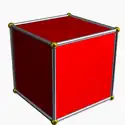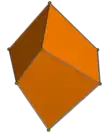In geometry, a cuboid is a hexahedron, a six-faced solid. Its faces are quadrilaterals. Cuboid means "like a cube", in the sense that by adjusting the lengths of the edges or the angles between faces, a cuboid can be transformed into a cube. In mathematical language a cuboid is a convex polyhedron whose polyhedral graph is the same as that of a cube.
A special case of a cuboid is a rectangular cuboid, with six rectangles as faces and adjacent faces meeting at right angles. A cube is a special case of a rectangular cuboid, with six square faces meeting at right angles.[1][2]
By Euler's formula the numbers of faces F, of vertices V, and of edges E of any convex polyhedron are related by the formula
In the case of a cuboid this gives 6 + 8 – 12 = 2; that is, like a cube, a cuboid has six faces, eight vertices, and twelve edges. Along with the rectangular cuboids, any parallelepiped is a cuboid of this type, as is a square frustum (the shape formed by truncation of the apex of a square pyramid).
| Quadrilaterally-faced hexahedron (cuboid) 6 faces, 12 edges, 8 vertices | ||||||
|---|---|---|---|---|---|---|
 |
 |
 |
 |
 |
 |
 |
| Cube (square) |
Rectangular cuboid (three pairs of rectangles) |
Trigonal trapezohedron (congruent rhombi) |
Trigonal trapezohedron (congruent quadrilaterals) |
Quadrilateral frustum (apex-truncated square pyramid) |
Parallelepiped (three pairs of parallelograms) |
Rhombohedron (three pairs of rhombi) |
| Oh, [4,3], (*432) order 48 |
D2h, [2,2], (*222) order 8 |
D3d, [2+,6], (2*3) order 12 |
D3, [2,3]+, (223) order 6 |
C4v, [4], (*44) order 8 |
Ci, [2+,2+], (×) order 2 | |
See also
References
- ↑ Robertson, Stewart Alexander (1984). Polytopes and Symmetry. Cambridge University Press. p. 75. ISBN 9780521277396.
- ↑ Dupuis, Nathan Fellowes (1893). Elements of Synthetic Solid Geometry. Macmillan. p. 53. Retrieved December 1, 2018.
External links
- Weisstein, Eric W. "Cuboid". MathWorld.
- Rectangular prism and cuboid Paper models and pictures